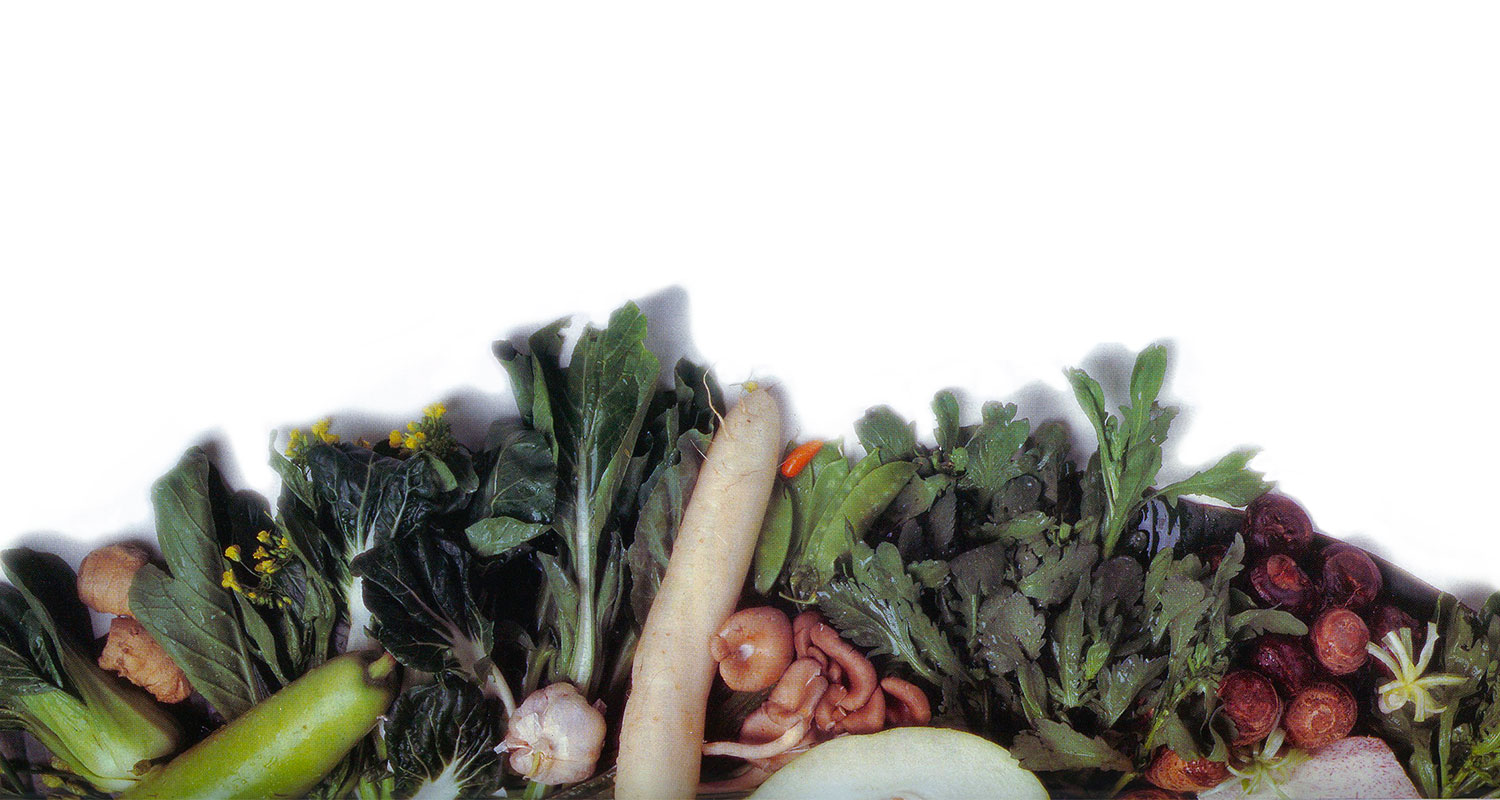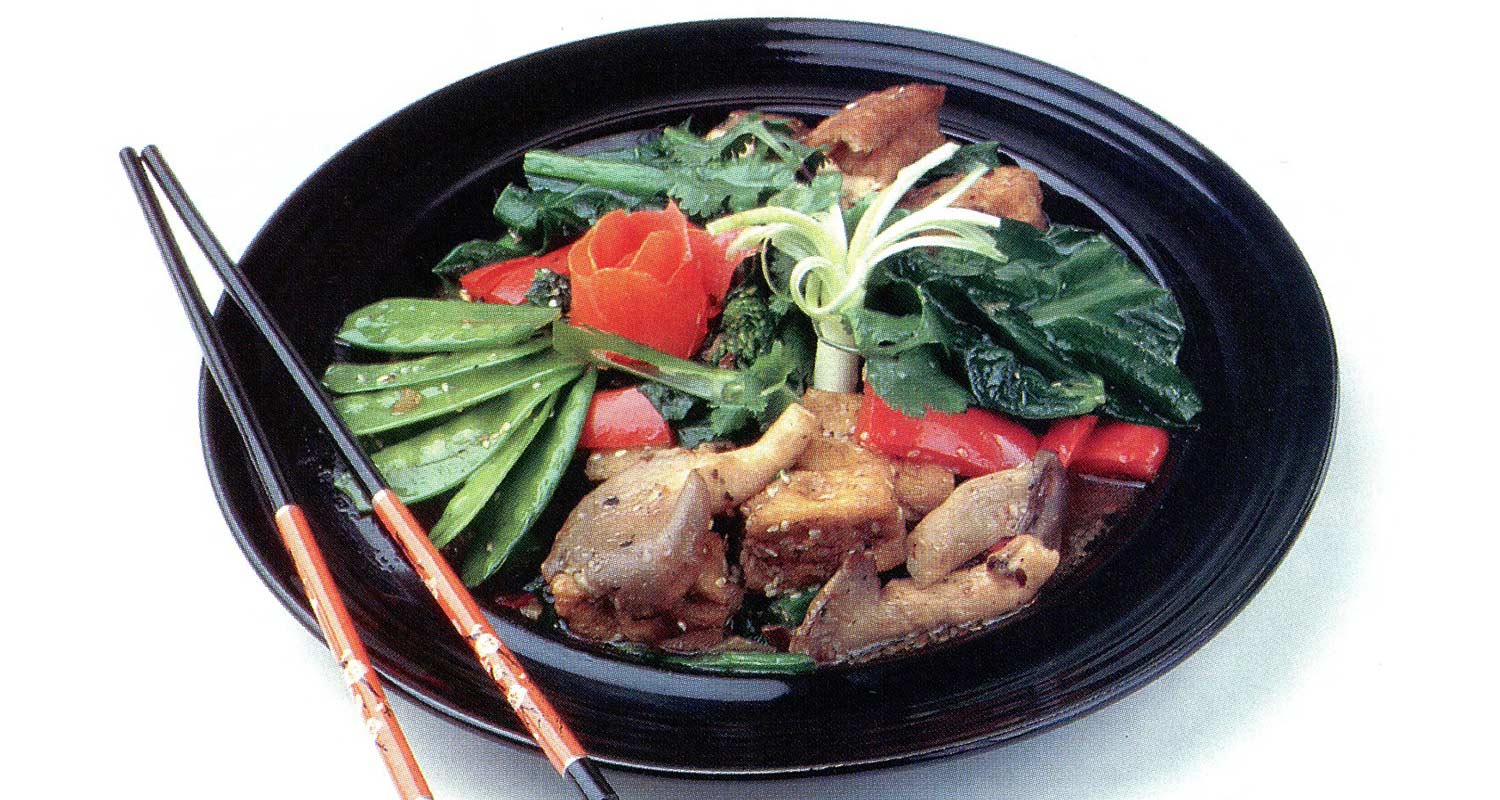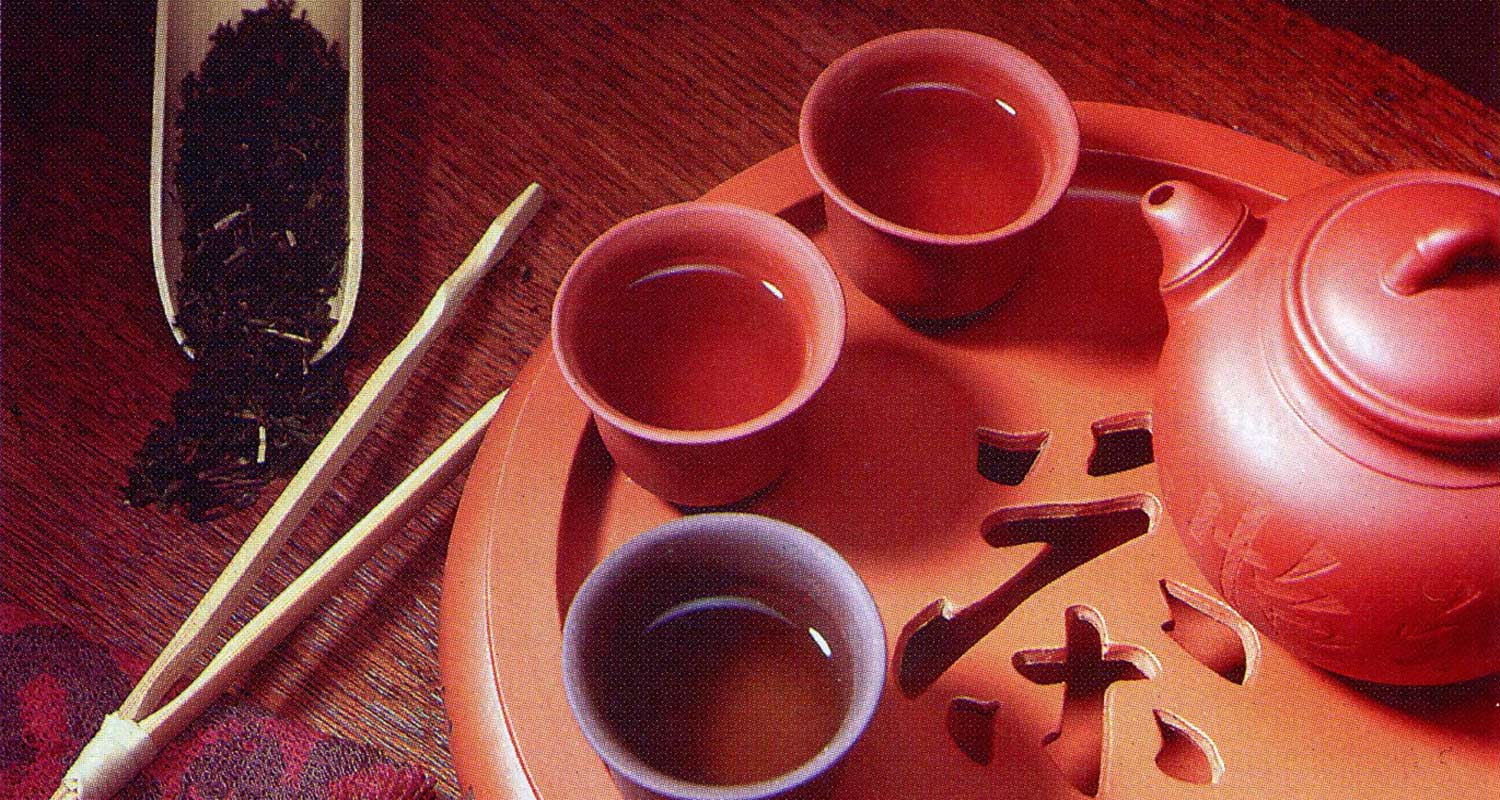Having people over for dinner? What vegetable will you serve? You’re sick of broccoli, you’ve done Brussels sprouts and you can’t stand to look at another green bean. You have got youself a bad case of vegetable ennui.
Fortunately, there is a solution. Unprecedented recent Chinese immigration, particularly from Hong Kong, has made exotic veggies-once found only in the big Chinatowns of New York, San Francisco and Vancouver -available at suburban green grocers and New Jersey strip malls. But what are they? Identification is the main obstacle with any foray into unfamiliar vegetation, especially when the signs are in a foreign language. So here is the answer, a culinary “field guide” on how to identify and prepare these vegetable delicacies and how to grow them right in your backyard or on your balcony.
Leafy Greens
Leafy greens as well as bringing an exotic touch to the North American dinner table, Chinese vegetables are extremely healthy. Pound-for-pound, leafy greens in the mustard family have more calcium than does cheddar cheese. Some say that because their calcium is more easily absorbed by the human body, these greens are superior even to dairy products as a calcium source. Broccoli, kale and cabbage are other members of this illustrious family.
The most commonly available Chinese mustards are bok choi, gai lan and choi sum. Bok choi probably needs no introduction. Piles of these dark green leaves with thick white stalks are a feature of almost any Chinese vegetable market. Gai lan, or Chinese kale, is often sold alongside bok choi. It has blue-green leaves on thick stalks of the same colour, often with little white flowers on the end. Gai lan makes a great broccoli substitute and has the added benefit that the thinner and less fibrous stalks can be served whole. The more seasonal choi sum looks similar to gai lan but is leafier and less stalky. It has a finer texture more like that of spinach.
The queen of Chinese leafy greens has to be tong ho, or garland chrysanthemum. Tong ho is not in the mustard family but is related to the “mum” flowers sold by florists and grown in gardens the world over. Its lobed, dark green leaves have a refreshingly bitter, flowery taste that is wonderful in soups and stews, as well as steamed, sautéed or stir-fried. The Chinese believe that tong warms the stomach and thereby stimulates digestion.
The classic way to cook leafy greens is to stir-fry them. Wash them, drain them well and then cut them into bite-sized pieces. Heat three tablespoons of a light oil in a frying pan or wok on a high heat. Add a crushed garlic clove until the fragrance is released, then, with a magnificent sizzle, add the greens. Toss them and, as they start to wilt, sprinkle them with a bit of fish sauce or soy sauce plus a splash of Chinese cooking wine or sake. The leafy greens can be served as soon as they wilt. Stalky greens can be covered and simmered with additional liquid for two to five minutes more, until tender.
Pea Shooting
Pea shooting snow peas and sugar snap peas are also candidates for the stir-fry. Most North Americans will have eaten, or at least seen, these sweet and tasty pods. To many people the snow pea is a quintessentially Chinese vegetable, but its origins are elsewhere. The Cantonese name for snow peas, hoh laan dau, is derived from holland apparently where snow peas came from.
More unusual to the Western palate is dau miu, or pea shoots. Available in most Chinatowns in late winter or early spring, they are unmistakable with their curly tendrils, small oval leaves and sometimes even a little pea flower or two. Pea shoots are wonderful when they are very lightly sautéed or stir-fried. Like all leafy greens, they shrink down considerably during cooking, so compensate accordingly.
Main Course Melons
Main course melons squashes, zucchinis and melons are members of the cucurbit family, which also, as you might guess, includes the cucumber. Two Chinese favourites are cheet gwa (fuzzy melon) and fu gwa (bitter melon). Be forewarned, however, that these are not dessert melons like cantaloupes or honey dews. Cheet gwa and fu gwa melons have their rightful place in the main course of a dinner.
Cheet gwa, the tamer of the two melons, resembles a fuzzy, blotchy and slightly fattened cucumber but tastes like a zucchini. Cheet gwa is great peeled, cut into little pieces and then stir-fried, steamed or used in soups and stews. Like zucchinis, the smaller fuzzy melons are firmer and tastier than the bigger ones.
Fu gwa is a more intense experience. Recognizable by its light-green, warty skin, this melon needs to be blanched in boiling water to get rid of its extreme bitterness. After blanching, fu gwa becomes refreshing, an ideal counterpoint to heavier foods such as meat. Fu gwa is often cooked with salty, fermented black beans. Admittedly, it is an acquired taste. Once you are addicted, however, you’ll find there is no going back.
Fu gwa recipes can be a bit complex, but a good place to get inspired by its unique bitterness is at a Buddhist vegetarian restaurant. Found in most larger Chinatowns, these restaurants often serve fu gwa stuffed with nuts, spiced tofu and black bean. Thus prepared, fu gwa can be an almost religious experience which you will surely want to recreate in your own kitchen.
Swamp Vegetables
Swamp vegetables we may not often think of a swamp when we wonder what’s for dinner, but some of China’s most delicately flavoured veggies are grown there. The most striking of these swamp-dwellers resembles a string of tan-coloured bananas, joined like sausage links. These are the roots of the lotus plant, leen ngau, a member of the water-lily family that holds an ancient and prominent place as a Buddhist icon.
The lotus root is a beautiful vegetable. First peeled, the root is then sliced cross-wise to reveal numerous tear-drop-shaped holes, which make the cross-section look like a flower or a round cathedral window.
For a simple, Japanese-style side dish, lightly fry the root slices in oil and add a little crushed red chili pepper to taste. Sprinkle with a good soy sauce, sake, sugar and water. Simmer until the water is reduced. Garnish with toasted sesame seeds and serve. The beautiful shapes will intrigue your dinner guests and the crunchy nut-like taste and crisp texture will complement any meal.
Two more frequently encountered swamp-vegetables are the water chestnut, or ma tai, and the arrowhead, or chee gwu. The water chestnut is recognizable by its dark brown colour and papery, concentric rings. It is not really a nut at all, but a root (called a corm by botanists) of a subtropical water plant. Freshwater chestnuts are sweet and crispy, much superior to the canned variety.
The arrowhead looks a bit more like a tulip bulb, with a sprout that is cut off before eating. Called duck potato in North America, arrowhead is not commonly eaten outside of Asia. In Vancouver’s Chinatown, however, large numbers of chee gwu appear in the markets around Chinese New Year. They are starchy, but the taste is crisper and sweeter than potato’s. Both water chestnuts and arrowheads must be peeled, and are then usually sliced and sautéed or lightly steamed. They make a wonderful addition to a stir-fry with leafy Chinese greens, or a sauté with mushrooms, chicken or shrimp.
Grow Your Own
Grow your own perhaps you’d even like to try your hand at growing Chinese veggies in your own backyard or on your balcony. Seeds for many of the above varieties can be purchased in Chinatown or, in the case of chee gwu, the same roots that you buy to eat can be planted. As Chinese vegetables get increasingly popular, many mail-order seed companies are starting to carry them. Some general planting tips follow.
The members of the broccoli tribe-bok choi, choi sum and gai lan-like to be grown during cooler times of the year. In temperate climates such as Vancouver’s, you can start them as early as late winter if you protect them with a rudimentary, clear plastic covering. Late summer sowings of these seeds will usually allow you to harvest bok choi and its relatives well into late fall and often into early winter months.
Snow peas also love cool weather. In Vancouver most gardeners like to plant before St. Patrick’s day. Sown too late, peas may become victims of nasty aphids. You can generally start harvesting the young shoots as soon as a month after sowing. This makes it easier to wait for the delicious pea pods, which are one of the crowning glories of the late-spring vegetable patch.
Unlike peas and bok choi, cheet gwa and fu gwa need hot, humid weather to thrive. Start the plants from seed early, indoors. Transplant them to the garden well after the danger of frost has passed. A challenge in cool climates, they benefit from being in a hot spot such as against the south wall of a building. Fu gwa, or bitter melon, likes a lot more heat than is available in the often inclement Vancouver summers, so it benefits much more from being grown under a clear plastic cover or a greenhouse. It’s worth experimenting, though, especially if you have a warm and protected garden plot or balcony.
Swamp plants, as you might expect, like to grow in wet places. Lotus plants and water chestnuts are subtropical so they don’t give much of a crop in cooler climates. Chee gwu, on the other hand, does well in northern climes and Vancouver backyards. Chinese gardeners often grow them in a miniature marsh made from an old bathtub filled with water and a bit of soil. The fresh corms are harvested within six months.
Whether homegrown or bought at the greengrocer, Chinese vegetables are sure to enliven jaded palates and make your next dinner party a hit. Don’t be afraid to experiment. Once you become aware of their unique flavours and textures, Chinese vegetables can be used in countless recipes. Remember, Chinese farmers have been growing these amazing vegetables for over 40 centuries. Chinese cooks have been delighting their dinner guests for just as long, so you have a lot of catching up to do.











